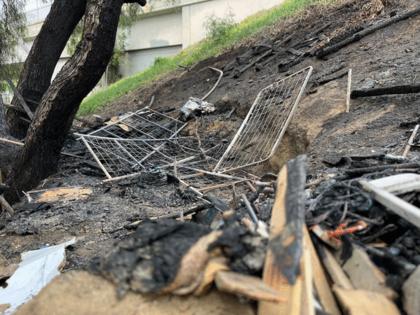California Gov. Gavin Newsom wanted encampments off state land. Fires by San Diego highways show there's a long way to go
Published in News & Features
SAN DIEGO — The woman woke up feeling hot. That’s how she discovered her hair was on fire.
The 47-year-old slapped at her head and scrambled from her tent, which sat beneath a bridge in southern San Diego, she recalled Wednesday during an interview at the site. Her Yorkshire terrier made it out, too. But the insulin she uses for her diabetes was lost.
“It went up fast,” said the woman, who spoke on the condition that only her middle name, La, be published. “I’m now scared to sleep.”
Fire department records show that the blaze at La’s tent began before sunrise on March 21. Two days later, a tree ignited near a different San Diego campsite. Both locations appear to be on land overseen by the California Department of Transportation, and the fires highlight the difficulties of keeping Caltrans property free of encampments when there are few places for homeless people to go.
Last summer, Gov. Gavin Newsom issued an executive order demanding that agencies quickly clear tent camps on state land. “It’s time to move with urgency,” Newsom said in a video. “There are no longer any excuses.” Yet in some cases there now seem to be more tents near San Diego’s highway on- and off-ramps, which are generally managed by Caltrans. Advocates for homeless people have pointed out that this shift happened after local governments passed camping bans that boosted penalties for sleeping on city sidewalks.
Rachel Laing, a spokesperson for Mayor Todd Gloria, estimated that since the start of last year more than 60 local fires had begun by encampments next to roadways. That total went up dramatically if you looked at all blazes within 100 feet of streets monitored by Caltrans, Laing wrote in an email, citing information from the fire marshal. (Fire department data previously shared with The San Diego Union-Tribune do note a number of incidents near highways, although records available to the public do not always specify the exact origin point.)
San Diego is negotiating with the state about potentially giving city crews more authority to clear encampments on California property. A sticking point may be who pays for what as collecting debris can be expensive. The city of San Diego needed a helicopter on Thursday to remove several tons of material from one abandoned encampment in La Jolla.
The state has given the region millions of dollars to aid homeless people and public data show that Caltrans has boosted sweeps in recent years. In 2024, the agency removed 943 encampments and about 4,600 cubic yards of debris from around San Diego, according to spokesperson Aaron Hunter.
But homelessness countywide continues to grow and there are nowhere near enough beds for everybody asking, despite ongoing efforts to launch additional shelters. And in a tough budget year — California faces a large deficit — it’s not clear whether Caltrans will get significantly more resources to monitor state land.
“Caltrans is responsible for protecting and maintaining the state’s highway network and regularly assesses potential safety and infrastructure threats on all of its state right of way properties, including fires,” the agency said in an emailed statement from Hunter. Caltrans didn’t yet have a record of blazes at the two San Diego sites that burned in March, although Hunter wrote that those locations had been “addressed nine times since 2022 and are scheduled to be cleaned again.”
The March 23 fire began around 3:30 a.m. on a steep hill overlooking Interstate 5, according to a fire department incident report obtained through a records request. Firefighters were able to put out the blaze in about 20 minutes before any houses were damaged.
Part of the hillside was still black when a reporter visited the area Wednesday. A pile of burned wood sat at the base of a pepper tree, its bark charred and ashy, and nobody was inside a nearby structure made out of tarp. Caltrans’ online map shows most of that land falling under the agency’s jurisdiction.
The same goes for the blackened plot where La’s tent burned earlier in the month. Several people appeared to still be sleeping at the site, including La, who wore a wrap around her head. She and a friend believe the fire may have been intentionally started by another person living outside, although suspicions were hard to prove.
La said outreach workers and police did come by, yet shelter was scarce. “Most of the time they don’t have a bed — not on the female side.” La added that she was on a list for housing.
Her friend, Thadius Wright, 64, said he does have a unit downtown, but was in the area to check on people he’d gotten to know during the years he slept at the site. Even though cleaning crews periodically moved the group out, the overpass offered too much protection from rain to fully abandon, Wright noted. “There’s nothing like being out here in the wintertime and being wet.”
Wright was convinced that most people would happily trade their tents for housing — if it was affordable. “They think we want to stay out here,” he said about frustrated neighbors. “Not true.”
©2025 The San Diego Union-Tribune. Visit sandiegouniontribune.com. Distributed by Tribune Content Agency, LLC.







Comments